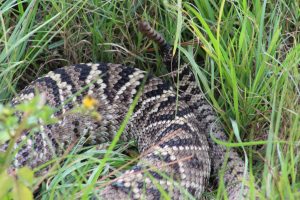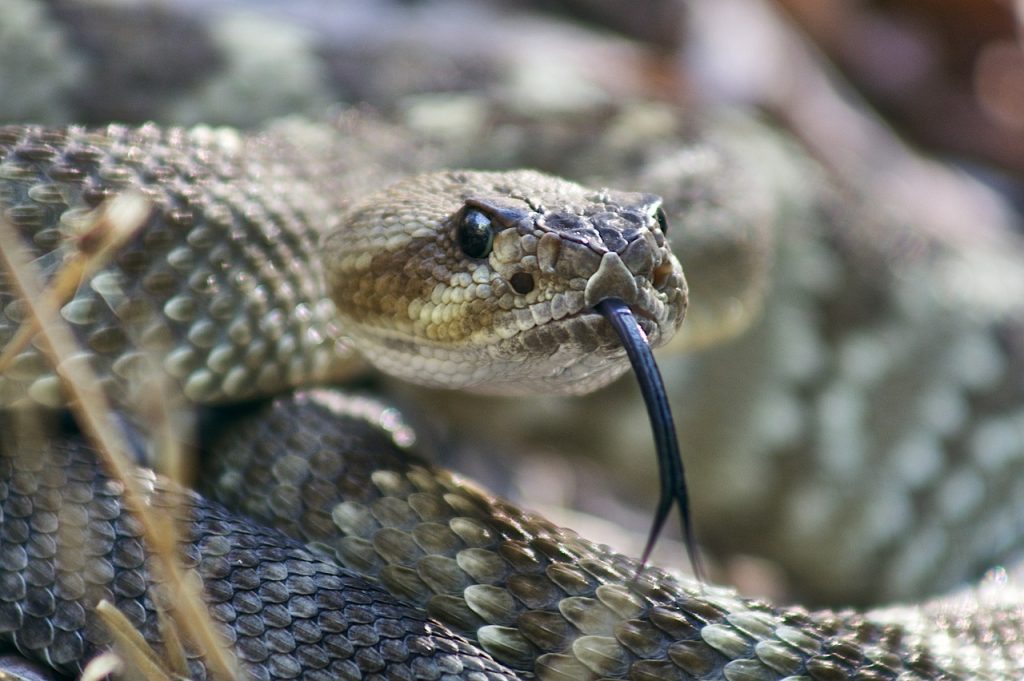
Snakes are an integral part of Florida’s healthy, well-functioning ecosystems. They help balance populations of rodents and other small mammals, reptiles, insects, and amphibians. Some snakes even eat other snakes, as well as some of our non-native and invasive animal species too!
Whether venomous or non-venomous, these serpents have also come to be the source of intense fear and aversion. With increased awareness, greater education, and an understanding of snake safety precautions, some of that fear can be replaced with knowledge, empowerment, and respect for these unique animals.
In part one of this two-part blog series, learn how to identify Florida’s venomous snake species. Head over to part two to learn what to do when you encounter a venomous snake, and best practices for staying safe and preventing negative interactions with both venomous and non-venomous snake species.
Learn about common non-venomous snake species found in Sarasota County, as well as a variety of other wildlife by reading other blogs in our Wild Sarasota blog series, or explore all the topics on our Florida Wildlife webpage.
Poisonous or Venomous- What’s the Difference?

Before we dive into today’s topic, let’s start with an important distinction. Many people mistakenly refer to venomous snakes as being poisonous. These two terms are often used interchangeably, despite having different meanings. A venomous animal is one that injects its toxins, often through a bite or a sting, as is the case with snakes and spiders that bite or wasps that sting. A poisonous substance or animal is one that has toxins that are absorbed into the body via eating/ingestion, inhalation, or absorption through the skin or mucous membranes. An example of this would be eating poisonous plants, or amphibians like poison dart frogs or cane toads, which can secrete poison through their skin, which can affect organisms that eat or sometimes even touch them!
Some animals can be both venomous and poisonous, and some can be venomous without being poisonous.
Florida’s Venomous Snake Species
In the state of Florida, there are around 46 species of native snakes, and among those, only 6 species are venomous to humans. This means that the majority of our snakes are non-venomous. Furthermore only 4 out of 6 venomous species are found in Sarasota County (indicated in bold). Florida’s 6 venomous snakes are:
- Copperhead (Agkistrodon contortrix)- Primarily along Apalachicola River and western parts of panhandle
- Timber Rattlesnake (Crotalus horridus)- Parts of north Florida and the panhandle
- Eastern Diamondback Rattlesnake (Crotalus adamanteus)- All counties in Florida incl. keys and barrier islands
- Dusky Pygmy Rattlesnake (Sistrurus miliarius barbouri)- All counties in mainland Florida
- Florida Cottonmouth– (Agkistrodon conanti)– All counties in Florida, incl. some keys and barrier islands
- Harlequin or Eastern Coral Snake (Micrurus fulvius)- All counties in Florida, incl. northern Florida Keys
One of my favorite things about our venomous snake species is their cool scientific names!
Identification Tips and Tricks
There are some general characteristics and identification tips that can be used to help distinguish between Florida’s venomous and non-venomous snake species. However, all species of wildlife, just like us humans, can exhibit variations and differences in coloration and physical characteristics within the same species. Sometimes, even the same animal’s physical features may change from season to season, during different times of the day, and may generally be hard to see from a safe distance. As such, it is important to note that some identification tips and tricks will not always be applicable or very pronounced.
Two Families
In Florida, venomous snakes belong to either of two families. The pit vipers (copperhead, timber, eastern diamondback, and dusky pygmy rattlesnakes, and cottonmouth), and the elapids (coral snake).
Pit Vipers
Pit vipers (sub family of the Viperidae) have heat sensing pits on either side of their face that detect small changes in temperature and allow them to hunt for warm-blooded prey in low light. Additionally, they have long, hinged fangs that lay folded when not in use. Here are a few characteristics that, when observed together, may help you identify venomous pit vipers in Florida:

- Blocky, triangular-shaped head that is distinct from the snake’s neck, caused by large venom glands in the mouth. In non-venomous species, head is usually round, thumb-shaped, with minimal distinction between head and neck. *However– many non-venomous snakes can flatten their head to mimic a venomous snake when they feel threatened*
- Vertically elliptical pupils, “cat eyes”. This feature is not true for all venomous snake species in Florida, like the coral snake. Additionally, non-venomous species may also have elliptical pupils, and a pit viper’s pupils may appear wider at times (Petty, 2019).
- Heat sensing pits on each side of the face.
- Dark-colored band or stripe that runs from the eye to the corner of the jaw (except for copperheads).
- Thick, stout body– rather than a long and slender appearance, some of our pit vipers will have a stout, heavy-bodied appearance.
- Keeled scales– all of our pit vipers in Florida have keeled scales, which give them a rougher, textured, matte appearance as opposed to sleek, smooth, shiny scales- some non-venomous species also have keeled scales.
Elapids
The Harlequin or Eastern coral snake is our only elapid in Florida. This family includes other highly venomous species around the world, such as cobras, mambas, taipans, sea snakes, and sea kraits. It has short, fixed fangs that do not fold in when its mouth is closed. As such, it is harder for this snake’s fangs to penetrate deeply. Coral snakes will often hold onto their prey and utilize a chewing motion to release venom, however, this does not mean that they cannot strike and release venom quickly.

A few identification tips that can be used together to identify a coral snake are:
- Snout or face is colored black– in comparison to other non-venomous lookalikes with red, black, and yellow or white banding found in Florida, the coral snake’s face is usually black. See Florida’s non-venomous lookalikes in this webinar.
- Red and black bands divided by a thinner, yellow band
- “Red touching black- venom lack, red touching yellow- kill a fellow”- if you cannot remember this rhyme, do not stick around to think about it!
- Round pupils
- Long, slender body
- Round, thumb-shaped head
- Smooth scales
***Important Note
When attempting identify pit vipers or coral snakes in Florida, know that the presence of only one or a few characteristics from each list does not always mean that the snake is venomous. There are non-venomous species that may share some of these characteristics. Never endanger yourself by approaching a snake in order to try to identify it. These tips and ticks should only be used when considering venomous snakes that are native to the state of Florida.
Learn More
- Dive deeper into Florida’s venomous snake species and their lookalikes, and view more images with this full-length webinar
- Read part two of this series to learn what to do when you encounter a venomous snake, and best practices for staying safe and preventing negative interactions with both venomous and non-venomous snake species.
- UF/IFAS EDIS Document: Recognizing Florida’s Venomous Snakes
- Florida Museum: Identify a Florida Snake
- UF Department of Wildlife Ecology and Conservation, Johnson Lab: Florida’s Snakes
Learn about common non-venomous snakes found in Sarasota.
Read all our Wild Sarasota blogs HERE.
Sources
- Petty, M. (2019, September 4). How Not to Identify a Venomous Snake. Medium. https://medium.com/natural-world
- Florida Museum. (n.d.). Florida Snake ID Guide- Eastern Diamond-backed Rattlesnake. Florida Museum. https://www.floridamuseum.ufl.edu/florida-snake-id/snake/eastern-diamond-backed-rattlesnake/
 1
1

